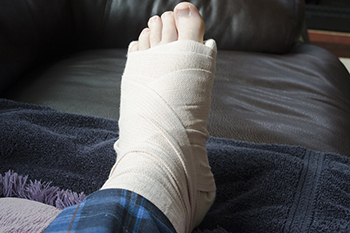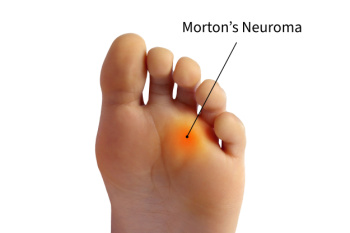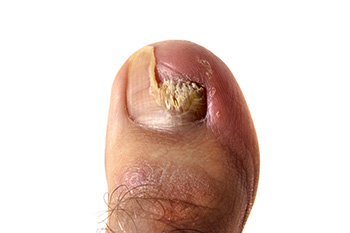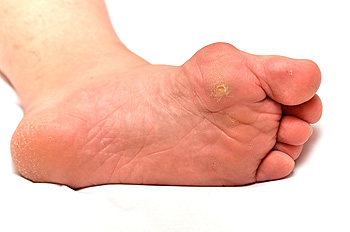Connect With Us
Blog
Items filtered by date: March 2025
How to Manage a Broken Foot

A broken foot can result from direct impact, falls, crush injuries, or repetitive stress. Symptoms include pain, swelling, bruising, limping, and difficulty bearing weight. The severity of a foot fracture depends on which of the 26 bones in the foot is affected. A podiatrist can diagnose your injury using X-rays or advanced imaging such as a CT scan. Treatment may involve immobilization with a stiff-soled shoe, boot, or brace to support healing. Some fractures, particularly those that involve joint surfaces or cause displacement, may require surgery to restore alignment. One possible complication of a foot fracture is non-union, which occurs when a broken bone fails to heal properly due to poor blood supply, continued movement at the fracture site, or other factors. This can lead to chronic pain and instability in the foot. Other complications include arthritis, if a joint is involved, and infection if the skin is broken. Recovery time depends on the type and location of the fracture. If you have a broken foot bone, it is suggested that you schedule an appointment with a podiatrist for an exam, diagnosis, and treatment options, which may include surgery.
A broken foot requires immediate medical attention and treatment. If you need your feet checked, contact one of our podiatrists from Cleveland Foot & Ankle Clinic. Our doctors can provide the care you need to keep you pain-free and on your feet.
Broken Foot Causes, Symptoms, and Treatment
A broken foot is caused by one of the bones in the foot typically breaking when bended, crushed, or stretched beyond its natural capabilities. Usually the location of the fracture indicates how the break occurred, whether it was through an object, fall, or any other type of injury.
Common Symptoms of Broken Feet:
- Bruising
- Pain
- Redness
- Swelling
- Blue in color
- Numbness
- Cold
- Misshapen
- Cuts
- Deformities
Those that suspect they have a broken foot shoot seek urgent medical attention where a medical professional could diagnose the severity.
Treatment for broken bones varies depending on the cause, severity and location. Some will require the use of splints, casts or crutches while others could even involve surgery to repair the broken bones. Personal care includes the use of ice and keeping the foot stabilized and elevated.
If you have any questions please feel free to contact our offices located in Cleveland, Independence, and Kent, OH . We offer the newest diagnostic and treatment technologies for all your foot and ankle needs.
Plantar Warts Can Be Treated!
Signs of Morton’s Neuroma

Morton's neuroma is a painful foot condition that typically affects the nerves between the third and fourth toes. It occurs when the tissue surrounding a nerve thickens, causing compression and irritation. Common symptoms include a sharp, burning pain in the ball of the foot, a feeling of something being stuck in your shoe, numbness, or tingling. The pain often worsens while walking or wearing tight shoes. The primary causes of Morton's neuroma include repetitive pressure on the foot, wearing high heels or tight footwear, and certain foot deformities like flat feet. Individuals who participate in high-impact sports or activities may also be more prone to developing a Morton’s neuroma. A podiatrist can help diagnose Morton's neuroma through a physical exam, imaging tests, and a review of your medical history. Treatment options include changes in footwear, orthotic inserts, corticosteroid injections, or surgery, in severe cases. If you are experiencing this type of pain, it is suggested that you schedule an appointment with a podiatrist who can accurately diagnose and treat Morton's neuroma.
Morton’s neuroma is a very uncomfortable condition to live with. If you think you have Morton’s neuroma, contact one of our podiatrists of Cleveland Foot & Ankle Clinic. Our doctors will attend to all of your foot care needs and answer any of your related questions.
Morton’s Neuroma
Morton's neuroma is a painful foot condition that commonly affects the areas between the second and third or third and fourth toe, although other areas of the foot are also susceptible. Morton’s neuroma is caused by an inflamed nerve in the foot that is being squeezed and aggravated by surrounding bones.
What Increases the Chances of Having Morton’s Neuroma?
- Ill-fitting high heels or shoes that add pressure to the toe or foot
- Jogging, running or any sport that involves constant impact to the foot
- Flat feet, bunions, and any other foot deformities
Morton’s neuroma is a very treatable condition. Orthotics and shoe inserts can often be used to alleviate the pain on the forefront of the feet. In more severe cases, corticosteroids can also be prescribed. In order to figure out the best treatment for your neuroma, it’s recommended to seek the care of a podiatrist who can diagnose your condition and provide different treatment options.
If you have any questions, please feel free to contact our offices located in Cleveland, Independence, and Kent, OH . We offer the newest diagnostic and treatment technologies for all your foot care needs.
Understanding Toenail Fungus

Toenail fungus is a common problem that many people face. It occurs when a fungus infects the nail, causing thickening, discoloration, and an unpleasant smell. The nail may become brittle, crumbling, or separated from the nail bed. This condition usually develops slowly and might go unnoticed until it worsens. Poor hygiene, damp environments, and minor injuries to the nail can contribute to its development. Over time, the fungus may spread to other nails and parts of the foot. Preventing the spread involves keeping feet clean and dry, wearing well-ventilated shoes, and avoiding sharing nail clippers. Early treatment can stop the infection from progressing and ease discomfort. For any ongoing issues or severe cases, it is suggested that you see a podiatrist for proper care.
If left untreated, toenail fungus may spread to other toenails, skin, or even fingernails. If you suspect you have toenail fungus it is important to seek treatment right away. For more information about treatment, contact one of our podiatrists of Cleveland Foot & Ankle Clinic. Our doctors can provide the care you need to keep you pain-free and on your feet.
Symptoms
- Warped or oddly shaped nails
- Yellowish nails
- Loose/separated nail
- Buildup of bits and pieces of nail fragments under the nail
- Brittle, broken, thickened nail
Treatment
If self-care strategies and over-the-counter medications does not help your fungus, your podiatrist may give you a prescription drug instead. Even if you find relief from your toenail fungus symptoms, you may experience a repeat infection in the future.
Prevention
In order to prevent getting toenail fungus in the future, you should always make sure to wash your feet with soap and water. After washing, it is important to dry your feet thoroughly especially in between the toes. When trimming your toenails, be sure to trim straight across instead of in a rounded shape. It is crucial not to cover up discolored nails with nail polish because that will prevent your nail from being able to “breathe”.
In some cases, surgical procedure may be needed to remove the toenail fungus. Consult with your podiatrist about the best treatment options for your case of toenail fungus.
If you have any questions, please feel free to contact our offices located in Cleveland, Independence, and Kent, OH . We offer the newest diagnostic and treatment technologies for all your foot care needs.
Differences Between Corns and Warts

Corns, calluses, and plantar warts are common foot conditions, but they have distinct causes, symptoms, and treatments. Corns are thickened areas of skin that develop on pressure points, often on the toes or soles, due to friction from wearing ill-fitting shoes or repetitive pressure. They can be painful, especially when walking. Plantar warts are caused by a viral infection, the human papillomavirus, or HPV, and typically appear as rough, raised growths on the bottom of the feet. Plantar warts are contagious and may cause discomfort when pressure is applied. Treatment for a plantar wart may involve freezing the wart with liquid nitrogen, laser treatments, or minor surgery to remove it. To treat a corn, start by addressing the cause of friction and pressure, such as wearing properly fitting shoes and using inserts or pads for cushioning. If a painful corn persists it can be safely removed by a podiatrist. If you have either of these ailments, it is suggested that you schedule an appointment with a podiatrist for a diagnosis and appropriate treatment.
Corns can make walking very painful and should be treated immediately. If you have questions regarding your feet and ankles, contact one of our podiatrists of Cleveland Foot & Ankle Clinic. Our doctors will treat your foot and ankle needs.
Corns: What Are They? And How Do You Get Rid of Them?
Corns are thickened areas on the skin that can become painful. They are caused by excessive pressure and friction on the skin. Corns press into the deeper layers of the skin and are usually round in shape.
Ways to Prevent Corns
There are many ways to get rid of painful corns such as:
- Wearing properly fitting shoes that have been measured by a professional
- Wearing shoes that are not sharply pointed or have high heels
- Wearing only shoes that offer support
Treating Corns
Although most corns slowly disappear when the friction or pressure stops, this isn’t always the case. Consult with your podiatrist to determine the best treatment option for your case of corns.
If you have any questions please feel free to contact our offices located in Cleveland, Independence, and Kent, OH . We offer the newest diagnostic and treatment technologies for all your foot and ankle needs.
Blog Archives
- April 2025
- March 2025
- February 2025
- January 2025
- December 2024
- November 2024
- October 2024
- September 2024
- August 2024
- July 2024
- June 2024
- May 2024
- April 2024
- March 2024
- February 2024
- January 2024
- December 2023
- November 2023
- October 2023
- September 2023
- August 2023
- July 2023
- June 2023
- May 2023
- April 2023
- March 2023
- February 2023
- January 2023
- December 2022
- November 2022
- October 2022
- September 2022
- August 2022
- July 2022
- June 2022
- May 2022
- April 2022
- March 2022

